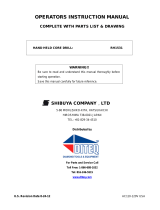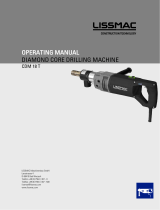
4 English 2215140
*2215140*
▶ Prevent unintentional starting. Ensure the switch is in the off-position before connecting to power
source and/or battery pack, picking up or carrying the tool. Carrying power tools with your finger on
the switch or energising power tools that have the switch on invites accidents.
▶ Remove any adjusting key or wrench before turning the power tool on. A wrench or a key left
attached to a rotating part of the power tool may result in personal injury.
▶ Do not overreach. Keep proper footing and balance at all times. This enables better control of the
power tool in unexpected situations.
▶ Dress properly. Do not wear loose clothing or jewellery. Keep your hair, clothing and gloves away
from moving parts. Loose clothes, jewellery or long hair can be caught in moving parts.
▶ If devices are provided for the connection of dust extraction and collection facilities, ensure these
are connected and properly used. Use of dust collection can reduce dust-related hazards.
▶ Do not let familiarity gained from frequent use of tools allow you to become complacent and ignore
tool safety principles. A careless action can cause severe injury within a fraction of a second.
Power tool use and care
▶ Do not force the power tool. Use the correct power tool for your application. The correct power tool
will do the job better and safer at the rate for which it was designed.
▶ Do not use the power tool if the switch does not turn it on and off. Any power tool that cannot be
controlled with the switch is dangerous and must be repaired.
▶ Disconnect the plug from the power source and/or remove the battery pack, if detachable, from
the power tool before making any adjustments, changing accessories, or storing power tools.
Such preventive safety measures reduce the risk of starting the power tool accidentally.
▶ Store idle power tools out of the reach of children and do not allow persons unfamiliar with the
power tool or these instructions to operate the power tool. Power tools are dangerous in the hands
of untrained users.
▶ Maintain power tools and accessories. Check for misalignment or binding of moving parts,
breakage of parts and any other condition that may affect the power tool’s operation. If damaged,
have the power tool repaired before use. Many accidents are caused by poorly maintained power
tools.
▶ Keep cutting tools sharp and clean. Properly maintained cutting tools with sharp cutting edges are
less likely to bind and are easier to control.
▶ Use the power tool, accessories and tool bits etc. in accordance with these instructions, taking
into account the working conditions and the work to be performed. Use of the power tool for
operations different from those intended could result in a hazardous situation.
▶ Keep handles and grasping surfaces dry, clean and free from oil and grease. Slippery handles and
grasping surfaces do not allow for safe handling and control of the tool in unexpected situations.
Service
▶ Have your power tool serviced by a qualified repair person using only identical replacement parts.
This will ensure that the safety of the power tool is maintained.
2.2 Diamond drill safety warnings
▶ When performing drilling that requires the use of water, route the water away from the operator’s
work area or use a liquid collection device. Such precautionary measures keep the operator’s work
area dry and reduce the risk of electrical shock.
▶ Operate power tool by insulated grasping surfaces, when performing an operation where the
cutting accessory may contact hidden wiring or its own cord. Cutting accessory contacting a “live”
wire may make exposed metal parts of the power tool “live” and could give the operator an electric
shock.
▶ Wear hearing protection when diamond drilling. Exposure to noise can cause hearing loss.
▶ When the bit is jammed, stop applying downward pressure and turn off the tool. Investigate and
take corrective actions to eliminate the cause of the bit jamming.
▶ When restarting a diamond drill in the workpiece check that the bit rotates freely before starting. If
the bit is jammed, it may not start, may overload the tool, or may cause the diamond drill to release from
the workpiece.
▶ When securing the drill stand with anchors and fasteners to the workpiece, ensure that the
anchoring used is capable of holding and restraining the machine during use. If the workpiece is
weak or porous, the anchor may pull out causing the drill stand to release from the workpiece.
▶ When securing the drill stand with a vacuum pad to the workpiece, install the pad on a smooth,
clean, non-porous surface. Do not secure to laminated surfaces such as tiles and composite
coating. If the workpiece is not smooth, flat or well affixed, the pad may pull away from the workpiece.
Printed: 09.08.2019 | Doc-Nr: PUB / 5431632 / 000 / 02























